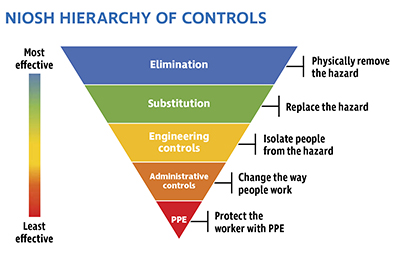 Occupational safety and health (OSH) professionals have a unique way of seeing the world.
Occupational safety and health (OSH) professionals have a unique way of seeing the world.
Most are vigilant about identifying hazards, assessing risks and protecting others even when they aren’t working, says Cathy Spigarelli, M.S., CHMM, corporate environmental health and safety manager for Encapsys LLC.
“It’s something we usually just can’t help,” she says.
While this dedication might make it difficult to relax and enjoy free time with loved ones, it makes OSH professionals a valuable asset to their communities — especially in times of crisis. As concerns about COVID-19, the novel coronavirus, started to mount, Spigarelli began thinking about how tools of the OSH profession could contribute to response efforts. She knew it was important to start with an essential safety framework.
“The hierarchy of controls is a foundational concept for solving OSH challenges,” she explains. “It consists of five ways to mitigate or eliminate a hazard that are ranked in order of effectiveness and, therefore, preference.”
Elimination
Elimination is the first and most effective control, Spigarelli says, and often involves physically removing a hazard.
“We can eradicate viruses by denying access to host cells so the virus is unable to replicate. Denying access comes in the form of effective vaccinations and transmission prevention.”
However, while researchers are working to develop a COVID-19 vaccine, it is important to note that no vaccine is 100% effective, according to the World Health Organization.
Substitution
Substitution is the act of replacing a given hazard with something less hazardous, says Spigarelli. In this case, that would mean replacing COVID-19 in the body of a patient.
“Administering a drug that interferes with the viruses’ ability to replicate once a person is infected is, in effect, making a more lethal virus into a less lethal one.”
While this is possible, Spigarelli says research — involving competent people, time and money — is needed to identify the correct drug. This work is underway for COVID-19, but may take a long time to get into the hands of people who need it.
Engineering Controls
Implementing engineering controls involves isolating people from a hazard or placing a barrier between them.
“A physical barrier, such as the glass transaction window that you might see at the bank, provides protection from viral exposure and is a form of engineering control,” she says. “For those doing research on this virus, work in a ventilation hood is another example of protection through use of an engineering control.”
These types of controls generally take time to produce and implement. In the mean time, administrative controls and PPE may be appropriate supplements.
Administrative Controls
Administrative controls, which involve changing the way people work or act, include changes in policy or procedures to reduce or minimize hazard exposure. Personal hygiene, isolation of people, limiting the size of gatherings and keeping a 6-foot separation between people are examples of administrative controls, says Spigarelli.
The downside is that compliance is needed for administrative controls be effective — and human beings are rarely perfect at compliance. The upside is that leaders can usually implement them more quickly than controls at the top of the hierarchy.
“Administrative controls can be a temporary solution, bridging the gap until more effective controls can be put in place,” she continues.
Personal Protective Equipment (PPE)
PPE — such gloves, masks and protective clothing that put a barrier between the worker and the hazard — is the least effective control.
“Training on the proper use and limitations of the PPE is needed,” says Spigarelli, “and lack of PPE where and when it is needed is also an issue.”
Despite the fact that PPE is at the bottom of the hierarchy, it has been a major focus during the COVID-19 pandemic. This is because, similar to administrative controls, PPE can be implemented quickly if it’s available.
The Big Picture
The prevalent use of lower-level controls in responding to COVID-19 highlights the importance of using this framework. While administrative controls and PPE can mitigate some risks while waiting for more effective solutions, according to Spigarelli, it’s critical to reassess every possible option in the hierarchy as leaders continue taking action throughout this health emergency.
“We can control this and other hazards by methodically working through each of level of the hierarchy and creatively applying controls to the problem,” she says.
Understanding Risk Management and Assessment
We have the resources and expert guidance you need to improve how you assess risks to prevent hazards, protect workers and safeguard equipment.
Learn more